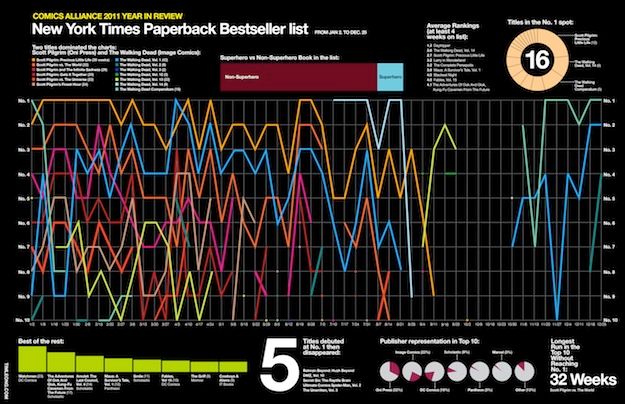Tim Leong, the art director for Wired and former editor-in-chief of Comic Foundry magazine, has come up with a pretty amazing infographic tracking the titles that have appeared on the New York Times paperback "graphic books" over the past year. The chart is great, but Tim also did some solid number-crunching, and there are lots of interesting results, starting with the fact that the charts were dominated not by Marvel or DC, but by Oni Press and Image.
This doesn't speak so much about comics as a whole as about a particular segment of the comics world: graphic novels and collected editions. Marvel and DC still dominate the world of single-issue comics sold in the direct market, but the Times looks at sales from independent and chain bookstores, online booksellers and newsstands, as well as comics shops. In that world, two indie properties, both backed by media tie-ins, ruled in 2011. (It would be interesting to see how the hardback charts compare; my guess is that they are more superhero-centric.)
The Hollywood Reporter makes a big deal about The Walking Dead dominating the charts this past week, saying, "No graphic novel series has ever dominated the list quite like Kirkman's Walking Dead," although a glance at Leong's chart makes it clear that Scott Pilgrim dominated even more, with the six volumes of Scott Pilgrim spending a total of 167 weeks on the charts compared to 102 weeks for the seven volumes of The Walking Dead. Incidentally, the next two books were Watchmen (of course!) and The Adventures of Ook and Gluck, Kung-Fu Cavemen from the Future, which is a kids' graphic novel by the author of the Captain Underpants books.
Leong's graphic provides a lot of food for thought. What happened in September, for instance, when all the Scott Pilgrim and Walking Dead books pretty much disappeared from the charts? (I looked at the charts for those weeks and nothing jumped out at me, but who knows?) What happened to the five books that came in at No. 1 and then disappeared? And is it better to hit the top spot for a couple of weeks or sit at a lower rank for almost a year? It's hard to see behind the rankings to hard numbers, but it does seem that the bookstore market is nurturing some diversity.

